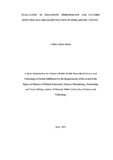| dc.description.abstract | Malaria disease is a global challenge and a major public health threat. Quality diagnosis of malaria is a key aspect of health care, as it provides an explanation of patient’s health problem and informs subsequent health care decisions. Microscopy is the reference test method for malaria diagnosis; however, the availability and utilization rate of malaria rapid diagnostic tests (mRDTs) has increased with time. World malaria report documents the evidence of gene deletion of plasmodium falciparum histidine rich protein 2 and 3 genes (pfhrp2/3), rendering malaria parasite undetectable with HRP2 based mRDTs that are commonly available. This may cause delay in treatment, misdiagnosis and in some cases death, hence the need to evaluate the diagnostic performance of mRDTs and the factors affecting them. The aim of the study was to evaluate the diagnostic performance and determine factors affecting mRDTs (histidine-rich protein2 (HRP2) and HRP2 combine with parasite lactate dehydrogenase (HRP2/pLDH) RDTs. Cross-sectional analytical study design was conducted in three purposively sampled health facilities (Ratta, Miranga and Manyuada) in Seme Sub County. The facility selection was based on workload, prevalence and the diagnostic methods used. Cochran formula was used to calculate the sample size. Convenience sampling was used to select the health care workers interviewed and a total of 223mRDTs each were randomly selected. Microscopy was used as a reference method to demonstrate the diagnostic performance of the different mRDTs using 223 whole blood sample panels collected from the patients suspected to have the disease. Structured questionnaire was administered to health care workers to assess the factors affecting mRDTs. Blood collections from the participants were done by a trained phlebotomist to minimize harm. Data analysis was done using Cohen Kappa Coefficient, MCNemar’s test, likelihood ratio, receiver operating characteristic (ROC) and descriptive statistics used for objective three. Presentation was done in charts, figures and tables. The results were as follows; for HRP2 RDTs, sensitivity (99.4%), specificity (85.7%), positive predictive value (81.0%) and negative predictive value (96.0%) and for pLDH/HRP2RDT,sensitivity (94.4%), specificity (85.0%), positive predictive value (80.2%), and negative predictive value (96.0%).HRP2 RDTs and microscopy gave a significant perfect agreement of (P-value<.001) and between microscopy and pLDH RDT of (P-value<.001).However, there was a significant disagreement between HRP2 and microscopy of P=.004 and HRP2/pLDH of P=.002. Further results revealed that both the mRDTs had minimum parasite density detection limit of 80 parasite/μl of blood and the Factors affecting the performance of mRDTs were as follows, 47% of health facilities had appropriate storage area, 18% of the health providers were able to checked and monitor the expiry dates, 39% reported availability of malaria commodities. Training for the health care workers in this study were below 60%. There was no evidence of internal and external quality control in place. In conclusion, the agreement between malaria positivity using microscopy and mRDTs positivity increased with increase in parasite density, however the mRDTs performance was below the expected world Health Organization expectation of ≥ 95%. Storage, quality assurance, end user training and commodity stock level monitoring in health facilities in Seme sub county were the factors affecting the performance of mRDTs. The study therefore advocates for more sensitive kit that can detect parasite at low density level for future use, especially to improve the sensitivity of mRDTs kits in malaria management where trained microscopist for malaria diagnosis are not available. Temperature monitoring of the storage areas for MRDTs, training of staff, quality assurance measures and proficiency testing is recommended for the effective performance of mRDTs. | en_US |

